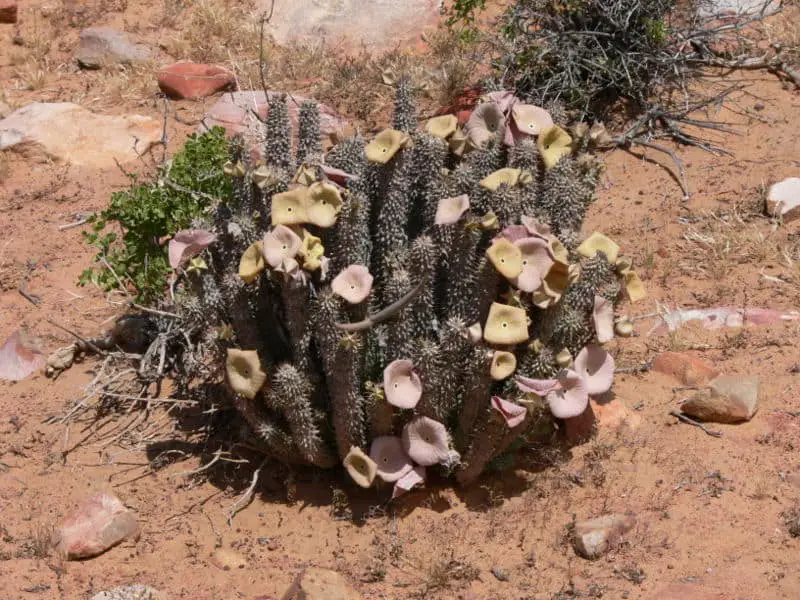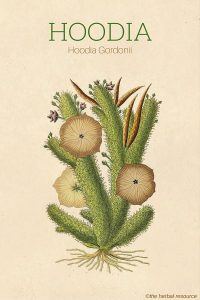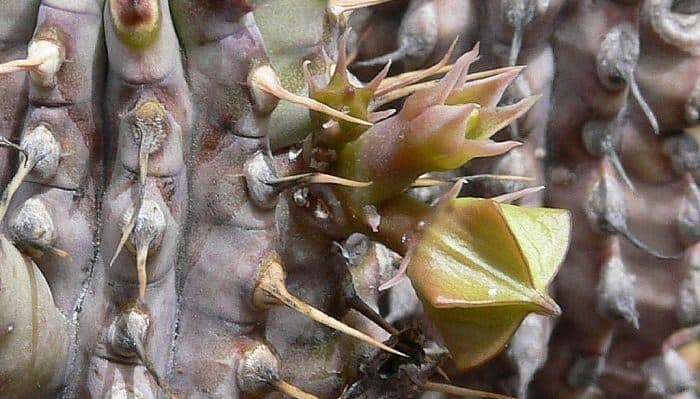Botanical Name: Hoodia gordonii.
Other Common Names: Bushman’s Hat, queen of the Namib, hoodia, xhooba, !khoba, Ghaap, hoodia cactus.
Habitat: Hoodia gordonii grows primarily in the Kalahari Desert of South Africa and also in Botswana, Namibia, and Angola.
Description: Hoodia is often mistaken for a cactus because of the resemblance but it is actually a succulent plant.
Hoodia gordonii can grow up to 50 cm in height and it has fleshy, ribbed and thorny stems. It emits a foul smell similar to rotten flesh to attract flies to the flowers to aid with pollination.
The flowers, that Hoodia gordonii produces, are purple and it can take up to five years for them to appear and then and only then can the plant be harvested.
Because it takes such a long time until the plant can be harvested and its scarceness, the commercial products made from it tend to be expensive.
Plant Parts Used: The fleshy part of the stem. The Bushmen of the Kalahari desert, also known by the name “khoi-San”, used Hoodia gordonii for thousands of years to ward off hunger and thirst while hunting and looking for food.
The active ingredient in hoodia cordonii is called p57, a steroidal glycoside, and it is this ingredient that is thought to suppress appetite.

Health Benefits, Therapeutic Uses and Claims of
Hoodia gordonii was first introduced to the U.S. market in early 2004 and it has quickly become one of the most popular herbal remedy for weight loss on the market.
There are more than 20 plant species in the genus Hoodia. Hoodia gordonii is the only species in that genus known to contain the active ingredient p57 which is thought to suppress appetite.
The active ingredient p57 in Hoodia gordonii was initially discovered and is patented by CSIR (The Council for Scientific and Industrial Research in South Africa).
A research study based on animal models published in the September issue (2004) of Brain Research found that if p57 was injected into the appetite center of the brain of rats it resulted in a loss of appetite. The rats that were given the P57 injections ate less than the rats that received plain placebo injections.
Hoodia gordonii is both scarce and expensive and therefore have some unscrupulous firms been selling products said to contain hoodia gordonii but do not contain it at all.
Other dishonest companies have been selling hoodia but just not hoodia gordonii containing the ingredient p57, so caution is advised when buying hoodia products.
Hoodia gordonii is on the list of CITES (Convention of Illicit Trade of Endangered Species) for protected plants which declares that it may not be harvested from the wild and growing and selling of the plant requires a special permit.
Dosage and Administration
It is often recommended to start with 800 to 1500 mg per day of Hoodia gordonii extract and gradually increase the dose up to 4500mg per day which is usually the maximum amount allowed per day.
The manufacturers’ doses should always be followed.
Potential Side Effects of Hoodia Gordonii
Hoodia gordonii is not considered a stimulant and there have not been any reports of negative side effects.
Still, more studies are needed for the long-term use of this herb so it should always be used with care.
Thordur Sturluson
Latest posts by Thordur Sturluson (see all)
- What is the Difference Between Hemp and Marijuana? - June 3, 2019


I have been having a tough time getting any of the legal importers of Hoodia to sell me any in a recognizeable form. I don’t need very much per year. For the use of my customers; I probably won’t be using more than a kilo a year.
The worst of the problems are that most of the CITES owning importers are trying to sell a powder. I’m not interested in buying what could be anything in powder format. I would like to buy it in slices.
Reason?
I’m going to tincture it. I’m going to macerate it in either white rum or distilled spirits like a vodkha for at least a month’s time, & then I will be adding distilled water & a natural tropically flavored glycerin to bring the alcohol content down below 20%.
Tincture goes under the tongue & does not impact the chemistry lab of the stomach in any way. Using the tincture makes it FEEL more medicinal which should keep it from being overused; although the label will of course also include a warning about the dangers of overuse & what a therapeutic level is.
Luckily, most herbalists & people who use herbals understand about therapeutic levels.
I also remind people about therapeutic levels & why it isn’t necessary to keep taking a high amount per serving as the body can hold only so much, & then any extra is just wasted.
My tinctures are bottled at 220 drops per bottle & the required amount per serving is a full dropperful every 4 hours, with a MAX of 3 servings over 12 hours.
It will most likely require 2 bottles per month to stay on the diet, but it allows for people to take it, log on for free at myfitnesspal.com; & make adjustments to their diets & log both their exercise & intake per day to see just where their diets fall down.
I’d like to think that I can find the hoodia gordonii sometime between now & October so that I have enough for the next season of dieting come January 2016. However, I’m beginning to wonder if I will ever find it in other than a powder that I can trust. I’m not a big manufacturer, I have to get a commercial kitchen to make the solution up for me as it is. But it is worth the wait. I lost 80 pounds on Hoodia in a blend 11 years ago, I know that I can do it again, but hoodia is the ingredient that seems to work the best for me to lose the appetite. I’ve tried other formulas to no avail.
Do you have any sources that you might know of?
I look forward to your reply.
I would contact the farms in South Africa directly and ask them if they would consider selling you the dried “chips” or slices directly. This place looks like a good choice: Farm Vredelus. I hope this helps.